What is the Research and Development (R&D) Tax Credit?
The R&D Tax Credit (26 U.S. Code §41) is a federal benefit that provides companies dollar-for-dollar cash savings for performing activities related to the development, design, or improvement of products, processes, formulas, or software. This credit provides much needed cash to hire additional employees, increase R&D, expand facilities, and more. The credit was enacted in 1981 to stimulate innovation and encourage investment in development in the US. Since then, many states have also passed the R&D Tax Credit. As such, this benefit is available across a wide variety of industries. Some of the common industries that qualify include, but are not limited to:
Estimate Your Benefits Instantly
Use our calculators for an estimate of state and federal benefits or to determine if you can offset payroll tax using the R&D tax credit. It's easy to use and free. If at any time you have questions, contact us. We are here to help you realize your maximum tax benefit.
What are the Potential Benefits of the R&D Tax Credit?
There are several benefits to realizing the R&D tax credit. These benefits can include the following:
- Receive up to 12-16 cents of federal and state R&D tax credits for every qualified dollar
- Create a dollar-for-dollar reduction in your federal and state income tax liability
- Increase earnings-per-share
- Reduce your effective tax rate
- Improve cash flow
- Carry forward the credit up to 20 years
- Perform look back studies to recognize unclaimed credits for open tax years (generally 3 or 4 years)
- Utilize the federal R&D tax credit against payroll tax (applicable to certain startup companies)
Four-Part Test
Qualified research activities are defined by the four-part test outlined below
Technological in Nature
Activities must fundamentally rely on the principles of physical or biological science, engineering, or computer science.
Permitted Purpose
Activities must be performed in an attempt to improve the functionality, performance, reliability, or quality of a new or existing business component.
Eliminate Uncertainty
Activities intended to discover information that could eliminate technical uncertainty concerning the development or improvement of a product.
Experimentation
All of the activities must include a process of experimentation including testing, modeling, simulating, systematic trial and error.
Research and Development Tax Insights

Virginia Research and Development Expenses Tax Credits Amended
04/15/2024KBKG Tax Alert: Virginia Research and Development Expenses Tax Credits Amended By Ian Williams| Principal, R&D Tax Credits Effective July 2024, Virginia’s Governor Youngkin signed legislation that impacts Virginia’s major research and development expenses tax credit. The changes include a decreased major R&D expenses cap, a new credit calculation method, and an increased R&D expenses … Read More
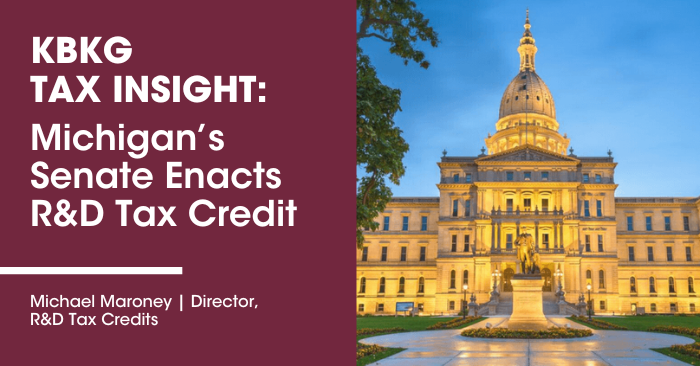
Michigan’s Senate Enacts R&D Tax Credit
03/25/2024KBKG Tax Insight: Michigan’s Senate Enacts R&D Tax Credit By Michael Maroney | Director, R&D Tax Credits On March 19, 2024, Michigan’s Senate passed legislation enacting an R&D credit, the first of its kind since the R&D credit expired over a decade ago. The Senate passed HB 5100, which the Democrat-led Michigan House passed on … Read More
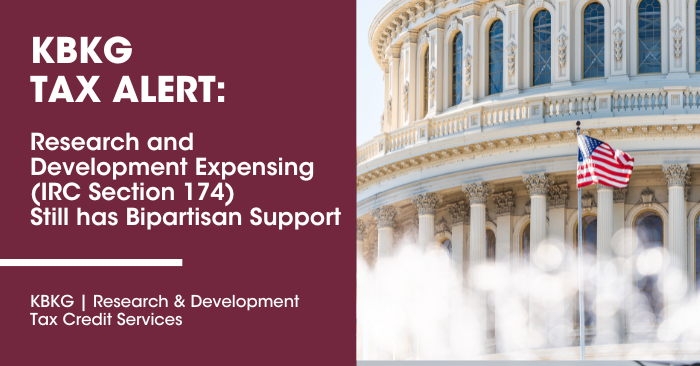
Research and Development Expensing (IRC Section 174) Still has Bipartisan Support
03/22/2024KBKG Tax Alert: Research and Development Expensing (IRC Section 174) Still has Bipartisan Support During a March 21 hearing on President Biden’s Fiscal 2025 budget, members of the Senate Finance Committee urged Treasury Secretary Janet Yellen to remember federal research and development (R&D) tax incentives to improve the United States’ economic competitiveness. The R&D tax … Read More
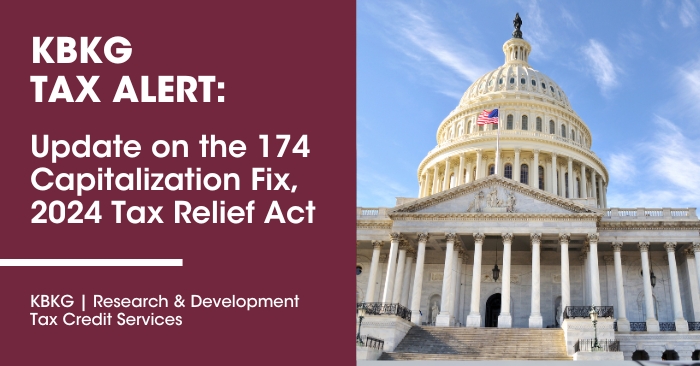
KBKG Tax Alert: Update on the 174 Capitalization Fix, 2024 Tax Relief Act
03/11/2024KBKG Tax Alert: Update on the 174 Capitalization Fix, 2024 Tax Relief Act The American Families and Workers Act of 2024 (“the Act”), aimed at reinstating the ability to deduct R&D expenditures, extending bonus depreciation, and expanding the Child Tax Credit has hit a significant roadblock in the Senate. Despite its bipartisan passage in the … Read More

Biotech R&D Tax Benefits
03/01/2024Understanding R&D Tax Credits for Biotech, Bioscience, and Pharma Research and development (R&D) is a huge part of the biotech, bioscience and pharmaceutical industries. Biotech, bioscience, and pharmaceutical companies operate on the forefront of innovation, constantly seeking new solutions to complex problems through cutting-edge technology and scientific research. R&D is the lifeblood of these industries, … Read More
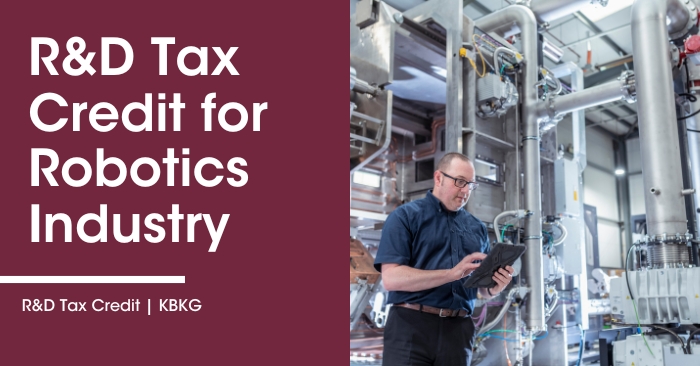
R&D Tax Credit for Robotics Industry
02/26/2024R&D Tax Credits for Robotics Industry If you run a small business, large corporation, or a startup, business payroll taxes could take a big bite out of your profitability. Companies in the robotics industry can lower their tax burden with the research and development (R&D) tax credit. This tax credit can help businesses developing exciting innovations … Read More

Common Misconceptions About R&D Tax Credits: Debunking Myths and Clearing Up Confusion
02/26/2024Common Misconceptions About R&D Tax Credits: Debunking Myths and Clearing Up Confusion The R&D credit refers to tax-saving opportunities for companies that invest in research and development. The R&D tax credit incentivizes businesses of all sizes to develop or improve products and processes within their industry. Unfortunately, many misconceptions may unnecessarily stop a company from claiming the … Read More
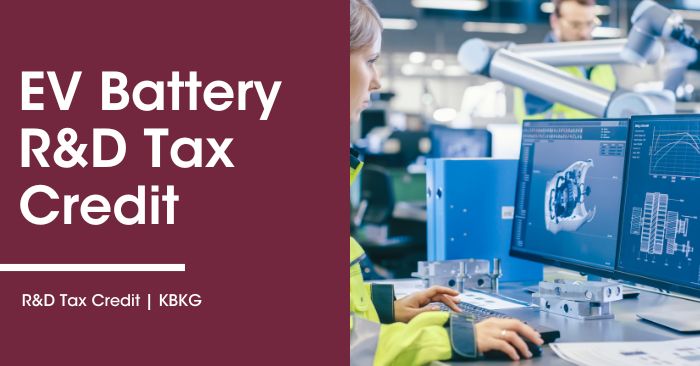
Tax Credits for Developing Battery Tech and Chemicals for Electric Vehicles
01/31/2024Using the R&D Tax Credit to Join the EV Market The production and sale of electric vehicles (EVs) are on the rise, with more consumers switching to this eco-friendly option each year. The EV market has witnessed substantial growth, driven by factors such as increasing environmental awareness, government incentives, advancements in battery technology, and improvements … Read More

How the PATH Act Helps Small Businesses
01/31/2024Understanding R&D Tax Credits for Forest Products | KBKG Companies in the forest products industry increasingly rely on research and development initiatives to optimize manufacturing, increase revenue, and create a competitive edge. Even small and medium-sized forestry businesses may qualify for valuable tax incentives related to R&D. Unfortunately, the U.S. Chamber of Commerce estimates that … Read More

Understanding R&D Tax Credits for Forest Products
01/31/2024Understanding R&D Tax Credits for Forest Products | KBKG Companies in the forest products industry increasingly rely on research and development initiatives to optimize manufacturing, increase revenue, and create a competitive edge. Even small and medium-sized forestry businesses may qualify for valuable tax incentives related to R&D. Unfortunately, the U.S. Chamber of Commerce estimates that … Read More



